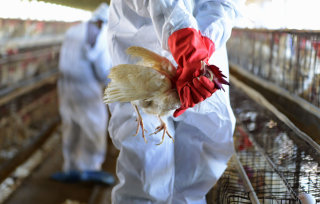- By Marketing
- In Mold Removal
USDA Unsure if Bird Flu Guidelines are Helping, GAO Finds
U.S. agriculture officials do not actually know if they are doing enough to protect people and poultry from avian influenza, a government watchdog reported Thursday.
The U.S. Department of Agriculture is still relying on poultry producers to voluntarily follow security guidelines, and many still are not doing everything they are supposed to do to protect their flocks, the non-partisan Government Accountability Office says in the report.

About 50 million birds died or were slaughtered in the outbreak of highly pathogenic H5N2 avian flu that spread to several states in 2014 and 2015, costing the U.S. economy an estimated $1 billion to $3.3 billion.
There have been smaller outbreaks since. The spread of bird flu threatens chicken and egg production but is also worrying because the viruses can infection people, too, sometimes. And worse, the technology to make flu vaccines to protect people from new outbreaks largely rely on chicken eggs.
Members of Congress asked the GAO to look into what USDA had done to improve U.S. farming practices.
It found the department had taken hundreds of actions, but had done too little to determine whether they were effective. And it found some big holes still in what poultry producers were doing.
Fewer than 60 percent of the 850 poultry producers surveyed had biosecurity officers or training in place, the GAO found. And less than 60 percent divided their poultry processing lines or provided employees a place to shower or change clothing before working on a poultry site, raising risks that workers could spread the virus around a plant or from one facility to another.

The USDA has created training programs and sought to encourage producers to improve security and hygiene with an interim rule that would keep them from being reimbursed for birds culled because of an outbreak.
According to the GAO’s report, these measures – and more than 300 others added after the 2014 outbreaks, some of which are ongoing – have not been tested to see if they are effective. The USDA agreed with the report’s single recommendation that it develop a plan to determine the worth of the measures.
“USDA’s Animal and Plant Health Inspection Service (APHIS) appreciates GAO’s recommendation and the opportunity to respond,” APHIS spokesperson Lyndsay Cole said in a statement. “APHIS agrees with the recommendation and has begun efforts to prioritize and complete all of the corrective actions as quickly as possible.”
The GAO pointed to another problem — wild birds.
Experts believe wild birds carry the viruses into the U.S. from Asia, and then spread them from one region of the U.S. to another. There is little that people can do to prevent that, the report says.
Related: Bird Flu Hits Tyson’s Chicken Farm in Tennessee
A bird surveillance program run jointly by the USDA and the Department of the Interior found roughly 0.12 percent of more than 88,000 wild birds surveyed carried a highly pathogenic strain of avian influenza of the same lineage that caused the 2014 and 2016 outbreaks.
None of the U.S. strains has spread to people, but two strains known as H7N9 and H5N1 have infected hundreds of people in China. Scientists fear one of these strains will mutate to become more infectious and might cause a pandemic of potentially deadly flu.
“We know the devastating impacts of a global pandemic. Now it’s up to the Department of Agriculture to make sure we are prepared and have a plan to combat this threat,” Tim Murphy, a Pennsylvania Republican, and Diana DeGette, a Colorado Democrat on the House Energy and Commerce subcommittee that ordered the report said in a joint statement.
Related: Spread of H7N9 Bird Flu Worries Officials in China
The GAO said the issue of egg production was particularly worrying.

“The virus could infect poultry needed to produce eggs used in manufacturing critical human vaccines against pandemic influenza,” the report notes. Domestic production of the vaccine would grind to a halt. And during a pandemic, foreign nations may not export the vaccines to the United States, instead preferring to save them for their own populations.
The Department of Health and Human Services contracted with a private company last year “to protect the egg supply chain and ensure a year-round supply of vaccine-quality fertilized eggs.” HHS is also working to help companies develop ways to make flu vaccines without the use of eggs.
GAO said there’s another problem, too. Flu viruses can infect pigs, and pigs can be infected both by human and by bird flu viruses. “Federal funding will soon be exhausted for a voluntary surveillance program that gathers information about the presence of influenza viruses in swine that could pose a threat to human health,” the report notes.
http://www.nbcnews.com/health/health-news/usda-unsure-if-bird-flu-guidelines-are-helping-gao-finds-n758021
